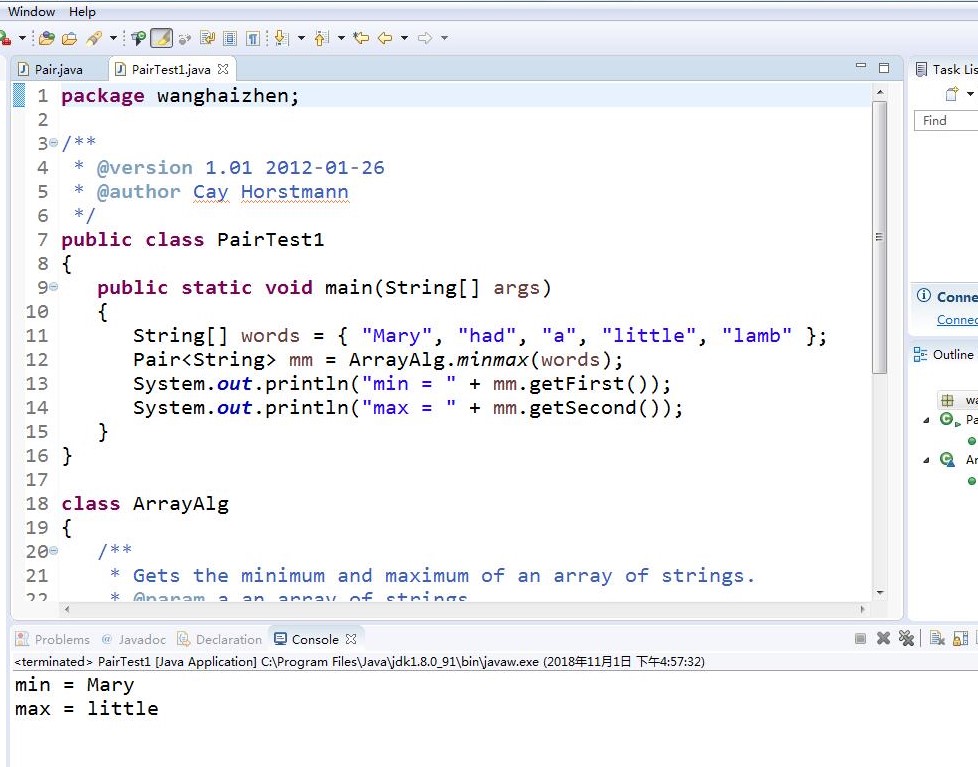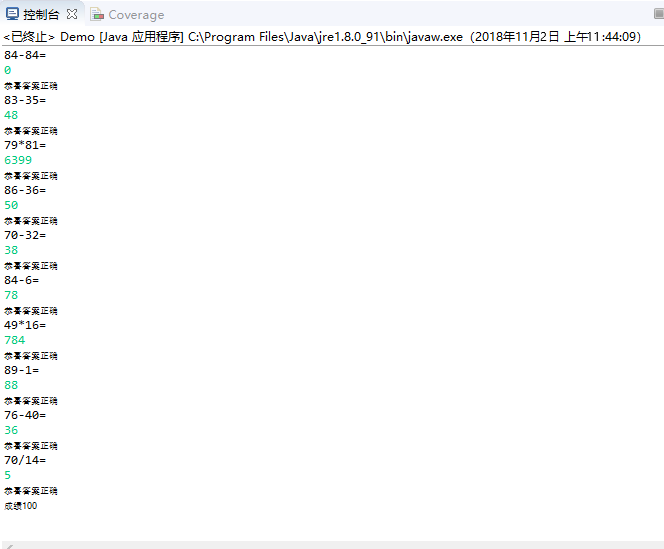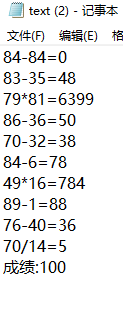---恢复内容开始---
1、实验目的与要求
(1) 理解泛型概念;
(2) 掌握泛型类的定义与使用;
(3) 掌握泛型方法的声明与使用;
(4) 掌握泛型接口的定义与实现;
(5)了解泛型程序设计,理解其用途。
2、实验内容和步骤
实验1: 导入第8章示例程序,测试程序并进行代码注释。
测试程序1:
l 编辑、调试、运行教材311、312页 代码,结合程序运行结果理解程序;
l 在泛型类定义及使用代码处添加注释;
l 掌握泛型类的定义及使用。 、
public class pair<T>//T是类型变量或参数化变量
{
private T first;
private T second;
public pair()
{
first = null; second = null;
}
public pair(T first, T second)
{
this.first = first;
this.second = second;
}
public T getFirst()
{
return first;
}
public T getSecond()
{
return second;
}
public void setFirst(T newValue)
{
first = newValue;
}
public void setSecond(T newValue)
{
second = newValue;
}
}
public class pair<T>//T是类型变量或参数化变量
{
private T first;
private T second;
public pair()
{
first = null; second = null;
}
public pair(T first, T second)
{
this.first = first;
this.second = second;
}
public T getFirst()
{
return first;
}
public T getSecond()
{
return second;
}
public void setFirst(T newValue)
{
first = newValue;
}
public void setSecond(T newValue)
{
second = newValue;
}
}
package Pari1;
/**
* @version 1.01 2012-01-26
* @author Cay Horstmann
*/
public class PairTest1
{
public static void main(String[] args)
{
String[] words = { "Mary", "had", "a", "little", "lamb" };
Pair<String> mm = ArrayAlg.minmax(words);
System.out.println("min = " + mm.getFirst());
System.out.println("max = " + mm.getSecond());
}
}
class ArrayAlg
{
/**
* Gets the minimum and maximum of an array of strings.
* @param a an array of strings
* @return a pair with the min and max value, or null if a is null or empty
*/
public static Pair<String> minmax(String[] a)
{
if (a == null || a.length == 0) return null;
String min = a[0];
String max = a[0];
for (int i = 1; i < a.length; i++)
{
if (min.compareTo(a[i]) > 0) min = a[i];
if (max.compareTo(a[i]) < 0) max = a[i];
}
return new Pair<>(min, max);
}
}

测试程序2:
l 编辑、调试运行教材315页 PairTest2,结合程序运行结果理解程序;
l 在泛型程序设计代码处添加相关注释;
l 掌握泛型方法、泛型变量限定的定义及用途。
package Pair2;
/**
* @version 1.00 2004-05-10
* @author Cay Horstmann
*/
public class Pair<T>
{
private T first;
private T second;
public Pair() { first = null; second = null; }
public Pair(T first, T second) { this.first = first; this.second = second; }
public T getFirst() { return first; }
public T getSecond() { return second; }
public void setFirst(T newValue) { first = newValue; }
public void setSecond(T newValue) { second = newValue; }
}
package Pair2;
import java.time.*;
/**
* @version 1.02 2015-06-21
* @author Cay Horstmann
*/
public class PairTest2
{
public static void main(String[] args)
{
LocalDate[] birthdays =
{
LocalDate.of(1906, 12, 9), // G. Hopper
LocalDate.of(1815, 12, 10), // A. Lovelace
LocalDate.of(1903, 12, 3), // J. von Neumann
LocalDate.of(1910, 6, 22), // K. Zuse
};
Pair<LocalDate> mm = ArrayAlg.minmax(birthdays);
System.out.println("min = " + mm.getFirst());
System.out.println("max = " + mm.getSecond());
}
}
class ArrayAlg
{
/**
Gets the minimum and maximum of an array of objects of type T.
@param a an array of objects of type T
@return a pair with the min and max value, or null if a is
null or empty
*/
public static <T extends Comparable> Pair<T> minmax(T[] a)
{
if (a == null || a.length == 0) return null;
T min = a[0];
T max = a[0];
for (int i = 1; i < a.length; i++)
{
if (min.compareTo(a[i]) > 0) min = a[i];
if (max.compareTo(a[i]) < 0) max = a[i];
}
return new Pair<>(min, max);
}
}

测试程序3:
l 用调试运行教材335页 PairTest3,结合程序运行结果理解程序;
l 了解通配符类型的定义及用途。
package pair3;
/**
* @version 1.01 2012-01-26
* @author Cay Horstmann
*/
public class PairTest3
{
public static void main(String[] args)
{
Manager ceo = new Manager("Gus Greedy", 800000, 2003, 12, 15);//创建了一个Manager类对象
Manager cfo = new Manager("Sid Sneaky", 600000, 2003, 12, 15);
Pair<Manager> buddies = new Pair<>(ceo, cfo);
printBuddies(buddies);
ceo.setBonus(1000000);
cfo.setBonus(500000);
Manager[] managers = { ceo, cfo };
Pair<Employee> result = new Pair<>();
minmaxBonus(managers, result);
System.out.println("first: " + result.getFirst().getName()
+ ", second: " + result.getSecond().getName());
maxminBonus(managers, result);
System.out.println("first: " + result.getFirst().getName()
+ ", second: " + result.getSecond().getName());
}
public static void printBuddies(Pair<? extends Employee> p)
{
Employee first = p.getFirst();
Employee second = p.getSecond();
System.out.println(first.getName() + " and " + second.getName() + " are buddies.");
}
public static void minmaxBonus(Manager[] a, Pair<? super Manager> result)
{
if (a.length == 0) return;
Manager min = a[0];
Manager max = a[0];
for (int i = 1; i < a.length; i++)
{
if (min.getBonus() > a[i].getBonus()) min = a[i];
if (max.getBonus() < a[i].getBonus()) max = a[i];
}
result.setFirst(min);
result.setSecond(max);
}
public static void maxminBonus(Manager[] a, Pair<? super Manager> result)
{
minmaxBonus(a, result);
PairAlg.swapHelper(result); //swapHelper捕获通配符类型
}
// 不能写公共静态 <T super manager> ...
}
class PairAlg
{
public static boolean hasNulls(Pair<?> p)//?表示:类型变量通配符
{
return p.getFirst() == null || p.getSecond() == null;
}
public static void swap(Pair<?> p) { swapHelper(p); }
public static <T> void swapHelper(Pair<T> p)
{
T t = p.getFirst();
p.setFirst(p.getSecond());
p.setSecond(t);
}
}
package pair3;
public class Manager extends Employee
{
private double bonus;
/**
@param name the employee's name
@param salary the salary
@param year the hire year
@param month the hire month
@param day the hire day
*/
public Manager(String name, double salary, int year, int month, int day)
{
super(name, salary, year, month, day);
bonus = 0;
}
public double getSalary()
{
double baseSalary = super.getSalary();
return baseSalary + bonus;
}
public void setBonus(double b)
{
bonus = b;
}
public double getBonus()
{
return bonus;
}
}
package pair3;
import java.time.*;
public class Employee
{
private String name;
private double salary;
private LocalDate hireDay;
public Employee(String name, double salary, int year, int month, int day)
{
this.name = name;
this.salary = salary;
hireDay = LocalDate.of(year, month, day);
}
public String getName()
{
return name;
}
public double getSalary()
{
return salary;
}
public LocalDate getHireDay()
{
return hireDay;
}
public void raiseSalary(double byPercent)
{
double raise = salary * byPercent / 100;
salary += raise;
}
}
package pair3;
/**
* @version 1.00 2004-05-10
* @author Cay Horstmann
*/
public class Pair<T>
{
private T first;
private T second;
public Pair() { first = null; second = null; }
public Pair(T first, T second) { this.first = first; this.second = second; }
public T getFirst() { return first; }
public T getSecond() { return second; }
public void setFirst(T newValue) { first = newValue; }
public void setSecond(T newValue) { second = newValue; }
}

实验2:编程练习:
编程练习1:实验九编程题总结
l 实验九编程练习1总结(从程序总体结构说明、模块说明,目前程序设计存在的困难与问题三个方面阐述)。
package IDcard;
import java.io.BufferedReader;
import java.io.File;
import java.io.FileInputStream;
import java.io.FileNotFoundException;
import java.io.IOException;
import java.io.InputStreamReader;
import java.util.ArrayList;
import java.util.Scanner;
import java.util.Collections;
public class ID {
public static People findPeopleByname(String name) {
People flag = null;
for (People people : peoplelist) {
if(people.getName().equals(name)) {
flag = people;
}
}
return flag;
}
public static People findPeopleByid(String id) {
People flag = null;
for (People people : peoplelist) {
if(people.getnumber().equals(id)) {
flag = people;
}
}
return flag;
}
private static ArrayList<People> agenear(int yourage) {
// TODO Auto-generated method stub
int j=0,min=53,d_value=0,k = 0;
ArrayList<People> plist = new ArrayList<People>();
for (int i = 0; i < peoplelist.size(); i++) {
d_value = peoplelist.get(i).getage() > yourage ?
peoplelist.get(i).getage() - yourage : yourage - peoplelist.get(i).getage() ;
k = d_value < min ? i : k;
min = d_value < min ? d_value : min;
}
for(People people : peoplelist) {
if(people.getage() == peoplelist.get(k).getage()) {
plist.add(people);
}
}
return plist;
}
private static ArrayList<People> peoplelist;
public static void main(String[] args) {
peoplelist = new ArrayList<People>();
Scanner scanner = new Scanner(System.in);
File file = new File("D:\\身份证号.txt");
try {
FileInputStream files = new FileInputStream(file);
BufferedReader in = new BufferedReader(new InputStreamReader(files));
String temp = null;
while ((temp = in.readLine()) != null) {
String[] information = temp.split("[ ]+");
People people = new People();
people.setName(information[0]);
people.setnumber(information[1]);
int A = Integer.parseInt(information[3]);
people.setage(A);
people.setsex(information[2]);
for(int j = 4; j<information.length;j++) {
people.setplace(information[j]);
}
peoplelist.add(people);
}
} catch (FileNotFoundException e) {
System.out.println("文件未找到");
e.printStackTrace();
} catch (IOException e) {
System.out.println("文件读取错误");
e.printStackTrace();
}//捕获异常
boolean isTrue = true;
while (isTrue) {
System.out.println("******************************************");
System.out.println(" 1.按姓名典序输出人员信息");
System.out.println(" 2.查询最大年龄人员信息");
System.out.println(" 3.查询最小年龄人员信息");
System.out.println(" 4.输入你的年龄,查询身份证号.txt中年龄与你最近的人");
System.out.println(" 5.查询人员中是否有你的同乡");
System.out.println(" 6.退出");
System.out.println("******************************************");
int nextInt = scanner.nextInt();
switch (nextInt) {
case 1:
Collections.sort(peoplelist);
System.out.println(peoplelist.toString());
break;
case 2:
int max=0;
int j,k1 = 0;
for(int i=1;i<peoplelist.size();i++)
{
j = peoplelist.get(i).getage();
if(j>max)
{
max = j;
k1 = i;
}
}
System.out.println("年龄最大:"+peoplelist.get(k1));
break;
case 3:
int min = 100;
int j1,k2 = 0;
for(int i=1;i<peoplelist.size();i++)
{
j1 = peoplelist.get(i).getage();
if(j1<min)
{
min = j1;
k2 = i;
}
}
System.out.println("年龄最小:"+peoplelist.get(k2));
break;
case 4:
System.out.println("年龄:");
int input_age = scanner.nextInt();
ArrayList<People> plist = new ArrayList<People>();
plist = agenear(input_age);
for(People people : plist) {
System.out.println(people.toString());
}
break;
case 5:
System.out.println("请输入省份");
String find = scanner.next();
for (int i = 0; i <peoplelist.size(); i++)
{
String [] place = peoplelist.get(i).getplace().split("\t");
for(String temp : place) {
if(find.equals(temp)) {
System.out.println("你的同乡是 "+peoplelist.get(i));
break;
}
}
}
break;
case 6:
isTrue = false;
System.out.println("byebye!");
break;
default:
System.out.println("输入有误");
}
}
}
}
Comparable接口:
package IDcard;
public class People implements Comparable<People> {
private String name = null;
private String number = null;
private int age = 0;
private String sex = null;
private String place = null;
public String getName()
{
return name;
}
public void setName(String name)
{
this.name = name;
}
public String getnumber()
{
return number;
}
public void setnumber(String number)
{
this.number = number;
}
public int getage()
{
return age;
}
public void setage(int age )
{
this.age = age;
}
public String getsex()
{
return sex;
}
public void setsex(String sex )
{
this.sex = sex;
}
public String getplace()
{
return place;
}
public void setplace(String place)
{
if(this.place == null) {
this.place = place;
}else {
this.place = this.place+ "\t" +place;
}
}
public int compareTo(People o)
{
return this.name.compareTo(o.getName());
}
public String toString()
{
return name+"\t"+sex+"\t"+age+"\t"+number+"\t"+place+"\n";
}
}
程序总体结结构:
Check类作为主类
Student类实现Comparable<Student>接口
模块说明:
主类Check类模块说明:1.导入文本文件;2.创建输入流,与文本文件中的信息进行匹配;3.控制台输出用户的选择,并使用catch语句对用户的选择作不同的操作
Student类模块说明:创建主类所需的变量所使用的一系列方法
目前设计程序存在的困难与问题:导入文本文件失败时的处理方式;由于C语言中没有Boolean类型,程序中对Boolean类型在整个程序中的使用不够熟练,常常使用较长的判断语句而忽略了布尔类型的运用
l 实验九编程练习2总结(从程序总体结构说明、模块说明,目前程序设计存在的困难与问题三个方面阐述)。
package 练习2;
import java.io.FileNotFoundException;
import java.io.PrintWriter;
import java.util.Scanner;
public class Suanshu1 {
public static void main(String[] args) {
Scanner in = new Scanner(System.in);
Suanshu Suanshu=new Suanshu();
PrintWriter output = null;
try {
output = new PrintWriter("ss.txt");
} catch (Exception e) {
//e.printStackTrace();
}
int sum = 0;
for (int i = 1; i < 11; i++) {
int a = (int) Math.round(Math.random() * 100);
int b = (int) Math.round(Math.random() * 100);
int s = (int) Math.round(Math.random() * 3);
switch(s)
{
case 1:
System.out.println(i+": "+a+"/"+b+"=");
while(b==0){
b = (int) Math.round(Math.random() * 100);
}
double c = in.nextDouble();
output.println(a+"/"+b+"="+c);
if (c == Suanshu.chu_fa(a, b)) {
sum += 10;
System.out.println("恭喜答案正确");
}
else {
System.out.println("抱歉,答案错误");
}
break;
case 2:
System.out.println(i+": "+a+"*"+b+"=");
int c1 = in.nextInt();
output.println(a+"*"+b+"="+c1);
if (c1 == Suanshu.chen_fa(a, b)) {
sum += 10;
System.out.println("恭喜答案正确");
}
else {
System.out.println("抱歉,答案错误");
}
break;
case 3:
System.out.println(i+": "+a+"+"+b+"=");
int c2 = in.nextInt();
output.println(a+"+"+b+"="+c2);
if (c2 == Suanshu.jia_fa(a, b)) {
sum += 10;
System.out.println("恭喜答案正确");
}
else {
System.out.println("抱歉,答案错误");
}
break ;
case 4:
System.out.println(i+": "+a+"-"+b+"=");
int c3 = in.nextInt();
output.println(a+"-"+b+"="+c3);
if (c3 == Suanshu.jian_fa(a, b)) {
sum += 10;
System.out.println("恭喜答案正确");
}
else {
System.out.println("抱歉,答案错误");
}
break ;
}
}
System.out.println("成绩"+sum);
output.println("成绩:"+sum);
output.close();
}
}
Suanshu类:
package 练习2;
public class Suanshu
{
private int a;
private int b;
public int jia_fa(int a,int b)
{
return a+b;
}
public int jian_fa(int a,int b)
{
if((a-b)<0)
return 0;
else
return a-b;
}
public int chen_fa(int a,int b)
{
return a*b;
}
public int chu_fa(int a,int b)
{
if(b!=0)
return a/b;
else
return 0;
}
}
程序总体结结构:
主类Caculator和Caculator1组成
模块说明:
主类Caculator:1.将程序所出的十道题目以及用户的作答以文本形式保存在Caculator.txt中;2.在0到100以内随机生成两个数作为用算数据,在0到3内随机生成一个数作为运算符号的选择符号;3.使用catch语句对0到3内随机生成一个数作为运算符号的选择符号进行匹配相应的运算;4.每答对一道题相应的得到10分,最后将所有分数进行累加并且答应输出
编程练习2:采用泛型程序设计技术改进实验九编程练习2,使之可处理实数四则运算,其他要求不变。
public class Suanfa<T> {
private T a;
private T b;
public Suanfa() {
a = null;
b = null;
}
public Suanfa(T a, T b) {
this.a = a;
this.b = b;
}
public int suanfa1(int a,int b)
{
return a+b;
}
public int suanfa2(int a,int b)
{
return a-b;
}
public int suanfa3(int a,int b)
{
return a*b;
}
public int suanfa4(int a,int b)
{
if(b!=0)
return a/b;
else return 0;
}
}
Demo:
import java.io.FileNotFoundException;
import java.io.PrintWriter;
import java.util.Scanner;
public class Demo {
public static void main(String[] args) {
Scanner in = new Scanner(System.in);
Suanfa counter=new Suanfa();
PrintWriter out = null;
try {
out = new PrintWriter("text.txt");
} catch (FileNotFoundException e) {
// TODO Auto-generated catch block
e.printStackTrace();
}
int sum = 0;
for (int i = 0; i <10; i++) {
int a = (int) Math.round(Math.random() * 100);
int b = (int) Math.round(Math.random() * 100);
int m= (int) Math.round(Math.random() * 3);
switch(m)
{
case 0:
System.out.println(a + "+" + b + "=");
int d0 = in.nextInt();
out.println(a + "+" + b + "=" + d0);
if (d0 == counter.suanfa1(a, b)) {
sum += 10;
System.out.println("恭喜答案正确");
} else {
System.out.println("抱歉,答案错误");
}
break;
case 1:
while (a < b) {
int x = a;
a = b;
b = x;
}
System.out.println(a + "-" + b + "=");
int d1 = in.nextInt();
out.println(a + "-" + b + "=" + d1);
if (d1 == counter.suanfa2(a, b)) {
sum += 10;
System.out.println("恭喜答案正确");
} else {
System.out.println("抱歉,答案错误");
}
break;
case 2:
System.out.println(a + "*" + b + "=");
int d2 = in.nextInt();
out.println(a + "*" + b + "=" + d2);
if (d2 ==counter.suanfa3(a, b)) {
sum += 10;
System.out.println("恭喜答案正确");
} else {
System.out.println("抱歉,答案错误");
}
break;
case 3:
while (b == 0 || a % b != 0) {
a = (int) Math.round(Math.random() * 100);
b = (int) Math.round(Math.random() * 100);
}
System.out.println(a + "/" + b + "=");
int d3 = in.nextInt();
out.println(a + "/" + b + "=" + d3);
if (d3 == counter.suanfa4(a, b)) {
sum += 10;
System.out.println("恭喜答案正确");
} else {
System.out.println("抱歉,答案错误");
}
break;
}
}
System.out.println("成绩"+sum);
out.println("成绩:"+sum);
out.close();
}
}


实验总结:
通过这次实验我了解了运用泛型程序设计的代码可以被很多不同类型的对象所重用。泛型类和泛型方法同时具备可重用性、类型安全和效率,泛型类不会强行对值类型进行装箱和拆箱,或对引用类型进行向下强制类型转换,所以是编程性能得到提高。自己还需要在编程方面多下功夫,还有很多不足之处。


